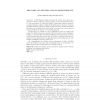Free Online Productivity Tools
i2Speak
i2Symbol
i2OCR
iTex2Img
iWeb2Print
iWeb2Shot
i2Type
iPdf2Split
iPdf2Merge
i2Bopomofo
i2Arabic
i2Style
i2Image
i2PDF
iLatex2Rtf
Sci2ools
EOR
2016
2016
The cost of getting local monotonicity
In [15] Manfred Holler introduced the Public Good index as a proposal to divide a public good among players. In its unnormalized version, i.e., the raw measure, it counts the number of times that a player belongs to a minimal winning coalition. Unlike the Banzhaf index, it does not count the remaining winning coalitions in which the player is crucial. Holler noticed that his index does not satisfy local monotonicity, a fact that can be seen either as a major drawback [9, 221 ff.] or as an advantage [16]. In this paper we consider a convex combination of the two indices and require the validity of local monotonicity. We prove that the cost of obtaining it is high, i.e., the achievable new indices satisfying local monotonicity are closer to the Banzhaf index than to the Public Good index. All these achievable new indices are more solidary than the Banzhaf index, which makes them as very suitable candidates to divide a public good. As a generalization we consider convex combinations of e...
EOR 2016 |
Related Content
| Added | 02 Apr 2016 |
| Updated | 02 Apr 2016 |
| Type | Journal |
| Year | 2016 |
| Where | EOR |
| Authors | Josep Freixas, Sascha Kurz |
Comments (0)

